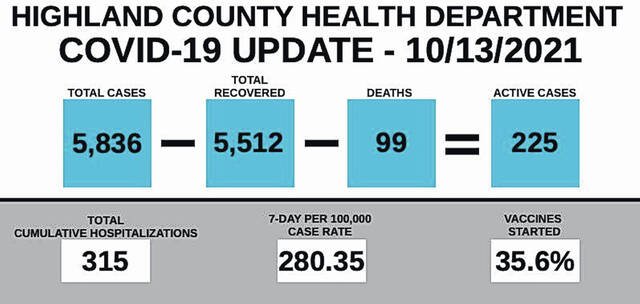Editor’s note — Highland County Health Commissioner Jared Warner posted an update focusing on COVID-19 on the health department’s Facebook page Wednesday. The slightly edited update appears below:
Cases
COVID-19 case counts dropped again over the last week but seem to have leveled off between 260 and 280 cases per 100,000 on a seven-day average. In real-world terms, this is between 16 and 18 new cases daily in the county, a big improvement from the height of our Delta wave which had a high of 59 new cases a day for the county. This leveling out of our case rate started around Oct. 7th, and it remains to be seen if we will continue our case decline again in the future.
Total hospitalizations have reached 315, and local hospitalization rates remain pretty high. Transfers to other facilities continue to be difficult. Regionally, hospitalization and ICU rates on average have slowly started to decline. A few other counties in Ohio are still in the middle of their Delta surge increase, and this will have some impact on hospital capacity across the state, even if our regional health care systems are beginning to improve.
Highland County has had 99 COVID-19 deaths since the start of the pandemic. Seventeen deaths have occurred in the last 14 days. This is an average of more than one death a day for the last two weeks.
COVID-19 death reporting
I had an interesting conversation about COVID-19 death counting at a community meeting this week, so I think it is worth clarifying again here.
COVID-19 deaths are recorded when COVID-19 is considered by the person’s doctor to be a necessary link in the chain of events that led to someone’s death. For example, let’s assume that an 85-year-old is obese, has lung cancer, and is in generally bad health. When they are infected with COVID-19, all of those underlying factors can come into play. If the person dies, and their doctor believes that COVID-19 was a part of the chain of events that led to that person’s death, then that death will be counted as a COVID-19 death. Without the COVID-19 infection, that death would not have occurred in this instance at the time when it occurred.
Similarly, if a healthy 42-year-old contracts COVID-19, gets severely ill, and dies, this too is categorized as a COVID-19 death. Without the COVID-19 infection, that death would not have occurred in this instance at the time when it occurred.
The question that doctors have to consider is whether COVID-19 in this specific instance led to that death.
Every death that gets reported in Highland County is reviewed by our team as well, to make sure that clerical errors or other issues do not impact our county COVID-19 death statistics. I hope that this explanation makes sense.
Schools and quarantine
Several Warren County schools have been using a modified quarantine policy for a couple of weeks now. The basic question is this: Is there a way for our schools to safely allow quarantined students (not sick, but exposed to a sick student) to stay in school during their quarantine period?
Warren County’s approach has been to use a combination of repeated rapid COVID-19 testing, additional social distancing (mainly at lunch when unmasked), required masks for those in quarantine while they are in school and no participation in extracurricular activities while in quarantine.
Unofficial information on this pilot project has been encouraging, but I am waiting to see official numbers. As Highland County sees rapid decreases in case counts as we come down from our Delta surge, our risk of widespread outbreaks in our schools also decreases. This may be the right time to consider implementing a policy like this locally, but we would really like to have some hard numbers from schools that have been using this approach so we can make better-informed decisions.
The other significant difference between Warren County and Highland County is the vaccination rate. Will a “Test to Stay” approach work well in a community with such low vaccination rates?
I hope to hear more soon from the Warren County experience soon so we can discuss our local options.
Immigration and COVID-19
And finally, I want to talk about an idea that I have heard discussed two different times now in Highland County. I don’t know how widespread this concept really is, and it could be that this doesn’t even need to be discussed. The general idea was about how poor border control practices and increased illegal immigration rates at the southern border have led to a wave of COVID-19 positive cases coming across our southern border, which are then leading to a significant increase and a spread of Delta variant cases in Ohio and across the country.
Normally, I wouldn’t get into a subject like this because it feels so directly political, and I try very hard to not be political (personally I think both parties have lost their marbles most of the time). From a public health perspective, my concern is that people are using this idea as a way to point blame somewhere other than where it really belongs, and I think that this is a mistake. When we consider our high COVID-19 case rates, we need to make sure that the finger of blame is firmly pointed at ourselves. If we would like to prevent any future COVID-19 surges in our community, our best option is still to get vaccinated, and our community continues to be reluctant to do that. This is where our attention needs to be.
Has illegal immigration impacted our national case counts? To some degree, I am sure it has. But it is a little like throwing a bucket of water into a swimming pool. There was an impact, but it was pretty wet in there already.





